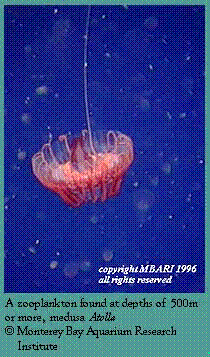 Unlike the boundaries of the MBNMS, which are geographically fixed, currents
move continuously through the area, carrying their drifting communities
as well as more active migrants that follow the seasonally changing communities of the drifters.
Some pelagic inhabitants of the MBNMS remain for longer periods, either
due to their swimming ability or because vertical migrations allow them
to alternately ride currents in opposing directions and thus stay in this region (Wroblewski
1982).
Unlike the boundaries of the MBNMS, which are geographically fixed, currents
move continuously through the area, carrying their drifting communities
as well as more active migrants that follow the seasonally changing communities of the drifters.
Some pelagic inhabitants of the MBNMS remain for longer periods, either
due to their swimming ability or because vertical migrations allow them
to alternately ride currents in opposing directions and thus stay in this region (Wroblewski
1982).
The waters of the MBNMS represent the coastal extension of the California Current, the eastern sector of the North Pacific gyre. Waters in the California Current, which mostly lies west of the MBNMS boundary, move equatorward carrying plankton that are mostly transitional zone species (but also some subarctic forms). These somewhat lower salinity waters provide the dominant oceanic species to surface waters in the MBNMS region. Inshore of the California Current, continental shelf waters may change direction regionally and seasonally. The inshore waters are home to neritic (continental shelf) species, some with benthic (bottom) resting stages. Below the surface and somewhat offshore, currents run northward along the continental slope in the higher salinity California Undercurrent, carrying populations from the south. In winter, this current often surfaces to become the poleward flowing Davidson Current, inshore of the equator-bound California Current. MBNMS waters contain mixes of populations from these different sources.
Water moves continuously through the MBNMS and, even in Monterey Bay, usually remains usually less than a week. This flushing is probably the reason that no endemic pelagic species are known for the region (U.S. GLOBEC Report 1994). The contribution of different source waters can change importantly over time, with the most dramatic alterations during El Niño-Southern Oscillation (ENSO) events. During an ENSO event, flow from the south increases, the water warms, sea level rises slightly, and fauna may change dramatically (McGowan 1984). Additional, decadal or longer scale changes are being discovered (e.g. Graham 1994); these changes are locally manifested by changes of intertidal organisms (Barry et al. 1995).
In addition to the major northward or southward flows in the MBNMS, satellites reveal a variety of more energetic and variable "mesoscale" (10s-100s km) oceanographic features that affect pelagic communities. Meanders and eddies of the California Current, together with cold filaments (narrow jets: Strub et al. 1991) propel coastal waters offshore at speeds sometimes exceeding 50 cm/sec, far faster than the long term average speeds of 5-10 cm/sec of the California Current (Brink and Cowles 1991). These recently discovered features redistribute organisms and have somewhat predictable locations (Barale and Fay 1986), with an offshore jet commonly found off Pt. Sur and an eddy or meander frequently outside Monterey Bay during the upwelling season (Rosenfeld et al. 1994). Intense upwelling also may wash out weakly swimming coastal zooplankton (Wroblewski 1980) and intense upwelling in the MBNMS region may explain the paucity of fish that produce near-surface pelagic eggs (Parrish et al. 1981). In northern Monterey Bay, an associated semi-permanent front often separates warm inshore water from cold, newly upwelled water moving downcoast (Graham 1993). This "upwelling shadow", known from satellite images, increases residence time in north Monterey Bay up to months, and the front contains dense populations of zooplankton that attract seabirds, schooling fish and marine mammals (Graham et al. 1992).
| < Previous Section I. Introduction |
||
